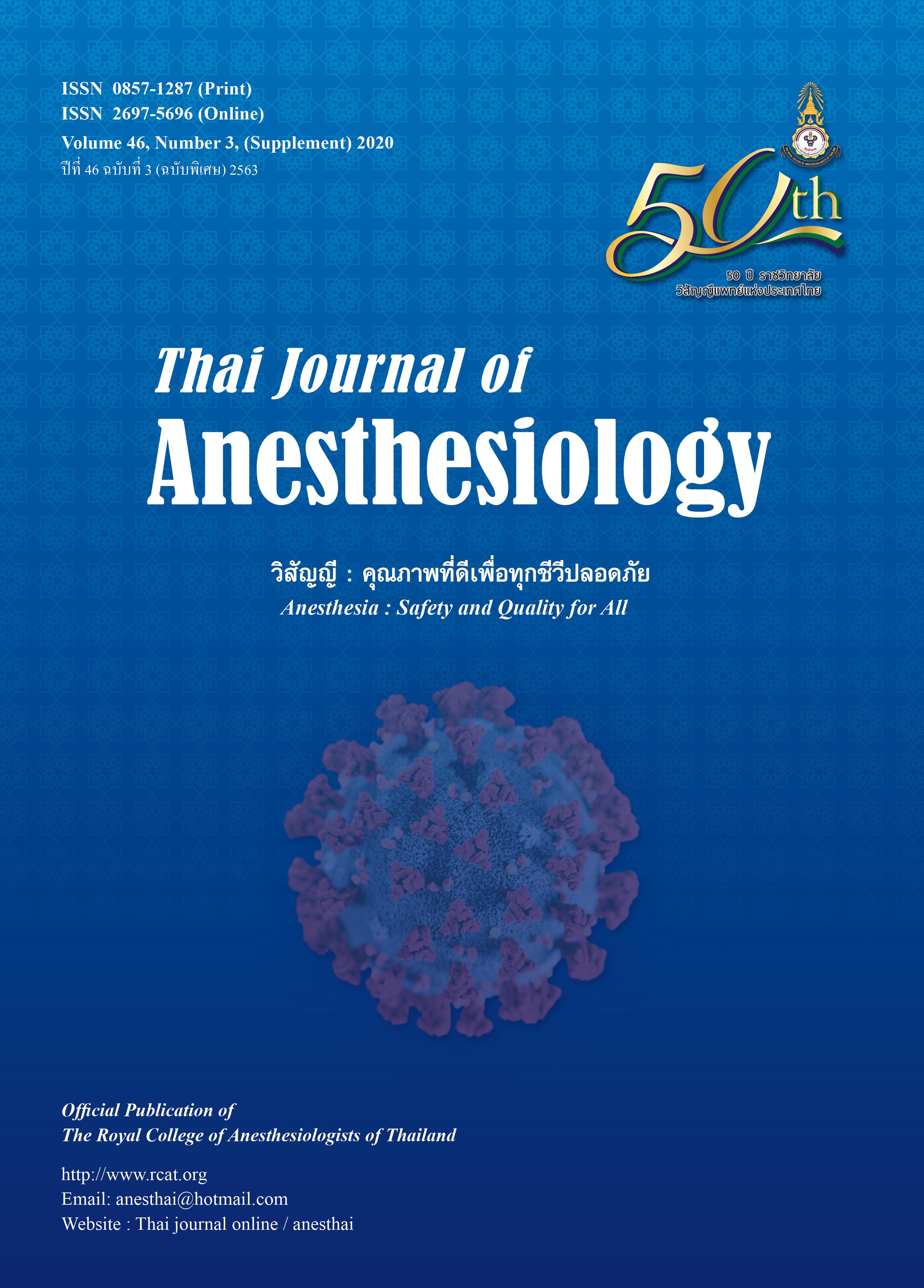The Impact of COVID-19 on Siriraj Anesthesiology Residency Training and the Use of E-Learning during a Pandemic
Main Article Content
Abstract
Coronavirus disease 2019 (COVID-19) has pervaded
across the globe, sending many countries into lockdown.
The impact of the pandemic on residency training is
discernible. Measures taken by various medical schools
all over the world are based on the social distancing policy,
inevitably disrupting medical education. An uncertain
prediction of the outbreak severity and duration serve as
urgent calls for educators to be versatile and innovative.
Thailand is the second country in the world to report a
confirmed case of COVID-19. Siriraj Anesthesiology
Department has adopted e-learning to facilitate residency
training during the outbreak. This paper intends to share
our response to the COVID-19 pandemic and suggests
possible implementation of e-learning to maintain the
integrity of medical education which consists of cognitive
skills, clinical skills and professionalism.
Article Details
References
2. Novel Coronavirus-Thailand (ex-China). 2020 [cited 2020 May 20]. Available from: https://www.who.int/csr/don/14- january-2020-novel-coronavirus-thailand-ex-china/en/.
3. The Department of Disease Control, Ministry of Public Health Thailand. Coronavirus disease (COVID-19). 2020 [cited 2020 May 22]. Available from: https://ddc.moph.go.th/viralpneu-monia/eng/index.php.
4. Wipatayotin A. At least 400,000 infections expected. Bangkok Post. Mar 2020 [cited 2020 May 8]. Available from: https:// www.bangkokpost.com/thailand/general/1880940/at-least- 400-000-infections-expected.
5. Ferguson N, Laydon D, Nedjati Gilani G, et al. Report 9: Impact of non-pharmaceutical interventions (NPIs) to reduce COVID19 mortality and healthcare demand. 2020. DOI: https://doi.org/10.25561/77482
6. Lim EC, Oh VM, Koh DR, Seet RC. The challenges of “continuing medical education” in a pandemic era. Ann Acad Med Singapore 2009;38:724-6
7. Ruiz JG, Mintzer MJ, Leipzig RM. The impact of e-learning in medical education. Acad Med 2006;81:207-12.
8. Sangrà A, Vlachopoulos D, Cabrera N. Building an inclusive definition of e-learning: an approach to the conceptual framework. IRRODL 2012;13:145-59.
9. Clark RC, Mayer RE. E-learning and the science of instruction: proven guidelines for consumers and designers of multimedia learning. 4th Edition. Texas: John Wiley & Sons; 2016.
10. Ten Cate O. Competency-based postgraduate medical education: past, present and future. GMS J Med Educ 2017;34:Doc 69.
11. ECFMG. ACGME Core competencies. Jul 2012 [cited 2020 May 13]. Available from: https://www.ecfmg.org/echo/ acgme-core-competencies.html.
12. Bloom BS. Taxonomy of educational objectives, handbook 1: cognitive domain. New York: David McKey; 1956.
13. Chumley-Jones HS, Dobbie A, Alford CL. Web-based learning: sound educational method or hype? A review of the evaluation literature. Acad Med 2002;77:S86-S93.
14. Kurup V, Hersey D. The changing landscape of anesthesia education: is flipped classroom the answer? Curr Opin Anesthesio 2013;26:726-31.
15. Anderson LW. A taxonomy for learning, teaching, and assessing: a revision of bloom’s taxonomy of educational objectives. In: Krathwohl, editor. New York: Longman; 2009.
16. Scriven M, Paul R, editors. Critical thinking as defined by the National Council for Excellence in Critical Thinking. 8th Annual international conference on critical thinking and education reform, Rohnert Park, CA; 1987.
17. Majumder MAA, Sa B, Alateeq FA, Rahman S. Teaching and assessing critical thinking and clinical reasoning skills in medical education. Handbook of research on critical thinking and teacher education pedagogy: IGI Global; 2019. p. 213- 33.
18. MacKnight CB. Teaching critical thinking through online discussions. Educause Quarterly 2000;23:38-41.
19. Al-Mubaid H. A new method for promoting critical thinking in online education. iJAC 2014;7:34-7.
20. Lage MJ, Platt GJ, Treglia M. Inverting the classroom: a gateway to creating an inclusive learning environment. J Econ Educ 2000;31:30-43.
21. Lunney M, Frederickson K, Spark A, McDuffie G. Facilitating critical thinking through online courses. J Asynchronous Learning Networks 2008;12:85-97.
22. DiPasquale J, Hunter W. Critical thinking in asynchronous online discussions: a systematic review. CJLT 2018;44:(2). DOI: https://doi.org/10.21432/cjlt27782
23. Sahoo S, Mohammed CA. Fostering critical thinking and collaborative learning skills among medical students through a research protocol writing activity in the curriculum. Korean J Med Educ 2018;30:109-18.
24. Kyaw BM, Posadzki P, Paddock S, Car J, Campbell J, Tudor Car L. Effectiveness of digital education on communication skills among medical students: systematic review and meta-analysis by the digital health education collaboration. J Med Internet Res 2019;21:e12967.
25. Triola M, Feldman H, Kalet AL, et al. A randomized trial of teaching clinical skills using virtual and live standardized patients. J Gen Intern Med 2006;21:424-9.
26. Herrmann-Werner A, Nikendei C, Keifenheim K, et al. “Best practice” skills lab training vs. a “see one, do one” approach in undergraduate medical education: an RCT on students’ long-term ability to perform procedural clinical skills. PLoS One 2013;8:e76354.
27. Romero P, Günther P, Kowalewski K-F, et al. Halsted’s “see one, do one, and teach one” versus peyton’s four-step approach: a randomized trial for training of laparoscopic suturing and knot tying. J Surg Educ 2018;75:510-5.
28. Nikendei C, Huber J, Stiepak J, et al. Modification of Peyton’s four-step approach for small group teaching-a descriptive study. BMC Med Educ 2014 Apr 2;14:68. doi: 10.1186/1472- 6920-14-68.
29. Khan H. An adaptation of Peyton’s 4-stage approach to deliver clinical skills teaching remotely. MedEdPublish 2020 Apr 23; DOI: https://doi.org/10.15694/mep.2020.000073.1
30. Cruess SR, Cruess RL. Professionalism must be taught. BMJ 1997;315:1674-7.
31. ABIM Foundation, American Board of Internal Medicine, ACP-ASIM Foundation, American College of Physicians, American Society of Internal Medicine, & European Federation of Internal Medicine. Medical professionalism in the new millennium: a physician charter. Ann Intern Med 2002; 136:243-6.
32. Swick HM. Toward a normative definition of medical professionalism. Acad Med 2000;75:612-6.
33. O’Sullivan H, Van Mook W, Fewtrell R, Wass V. Integrating professionalism into the curriculum: AMEE Guide No. 61. Med Teach 2012;34:e64-e77.
34. Lumlertgul N, Kijpaisalratana N, Pityaratstian N, Wangsaturaka D. Cinemeducation: a pilot student project using movies to help students learn medical professionalism. Med Teach 2009;31:e327-e32.
35. Lepp M, Zorn CR, Duffy PR, Dickson RJ. International education and reflection: transition of Swedish and American nursing students to authenticity. J Prof Nurs 2003;19:164-72.
36. Kissler SM, Tedijanto C, Goldstein E, Grad YH, Lipsitch M. Projecting the transmission dynamics of SARS-CoV-2 through the postpandemic period. Science 2020;368:860-8.


